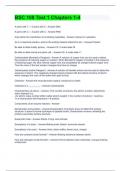BSC 108 Test 1 Chapters 1-4
A pairs with T → G pairs with C - Answer-DNA
A pairs with U → G pairs with C - Answer-RNA
Area within the membrane not including organelles - Answer-Cytosol or cytoplasm
As in a chemical reaction, what is the ending material referred to as? - Answer-Product
Be able to label Acidity picture. - Answer-Ch. 2 notes slide 40
Be able to label animal and plant cell. - Answer-Ch. 4 notes slide 11
Carbohydrate (Benedict's Reagent) - Answer-A solution of copper ions can be used to detect
the presence of reducing sugars in solution. When Benedict's reagent is heated in the presence
of reducing sugar, the blue colored copper ions are precipitated as orange-colored copper ions.
Thus the color of the test solution changes from blue to orange.
Carbohydrate (Iodine Reagent) - Answer-A solution of triiodide anions can be used to detect the
presence of starch. The negatively charged anions interact with the helical structure of starch,
which changes the color of the iodine from gold to blue.
Cellulose - Answer-the most abundant organic compound on earth
Cellulose is a _________. - Answer-Carbohydrate
Characteristics of atoms: - Answer--The number of protons, the atomic number, determines
which element it is.
-An atom's mass number (often called atomic weight) = the number of protons + neutrons.
-In a neutral atom the # electrons = # protons
Components of an enzyme reaction - Answer-
Denaturation and proteins - Answer-Desaturation of proteins does not affect the primary
structure- it doesn't involve hydrolysis of peptide bonds. Denaturation involves unfolding the
proteins secondary tertiary structure.
Eukaryotic Cells - Answer-Plants, Fungi, and Animals
Example(s) of a base. - Answer-Baking soda, bleach, ammonia cleaner
Example(s) of an acid. - Answer-Urine, black coffee, lemon juice, vinegar
How are covalent bonds formed? - Answer-Sharing electrons between atoms
How are hydrogen bonds formed? - Answer-Forms between polar molecules, unequal sharing
of electrons
, How are ionic bonds formed? - Answer-Attraction between positive and negative ions
How can you determine atomic number from atomic mass? - Answer-Atomic mass is protons +
neutrons with neutral atom and atomic number of protons
How do cells move? - Answer-Flagella
How do the bases pair in a DNA strand? - Answer-DNA: A pairs with T → G pairs with C
How do the bases pair in a RNA strand? - Answer-RNA: A pairs with U → G pairs with C
How do you define something as living? - Answer-Anything that is complex and made of
chemicals, something that needs to eat food, life cannot be defined.
How does the hydrogen bond contribute to the properties of water? - Answer-Main unique
properties of water are due to hydrogen bonds. Ice floating, high heat vaporization, strong
surface tension, and high specific heat
How many electrons are found in the first energy shell? Second? Third? - Answer-2, 8, 18
In a chemical reaction what is beginning material known as? - Answer-Reactant
Know examples of each macromolecule. - Answer-Carbohydrates: Monosaccharide,
Disaccharide, Polysaccharide
Lipids: fatty acids, Triglycerides, Phospholipids, Steroids
Proteins: amino acids, Enzymes
Nucleic Acids: DNA & RNA, nucleotide triphosphates
Lipids (Sudan Red Dye) - Answer-Sudan red dye is soluble in lipids but is insoluble in water.
When Sudan red is added to a mixture containing lipids the dye will bind to the lipid producing a
red color wherever the lipids are found. If no lipids are present the dye will float on the surface of
the water.
List the four basic macromolecules. - Answer-Carbs, lipids, nucleic acid, proteins
List the four kingdoms in Eukarya. - Answer-Animalia, Plantae, Fungi, and Protista
List the functions of the rough ER. - Answer-Modify membrane proteins, and secretory proteins.
List the major types of proteins. - Answer-Structural, storage, contractile, transport, enzymes
List the steps of the scientific method. - Answer-1. Observe (The lamp is not working)
2. Question (Why isn't the lamp working?)
3. Hypothesize (The lamp isn't working b/c is is unplugged)
4. Predict
5. Experiment (Check to see if lamp is unplugged)
6. Analyze (Accept or Reject Hypothesis) (Accepted if lamp is unplugged; Rejected if lamp is
plugged in)
List the three domains. - Answer-Eukarya, Bacteria, and Archae




